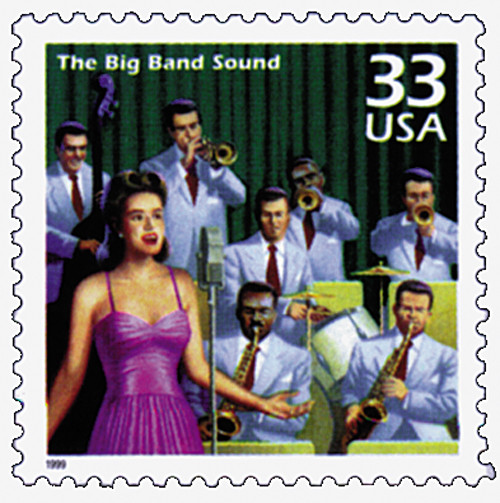
# 3186j - 1999 33c Celebrate the Century - 1940s: The Big Band Sound
US #3186j
1999 The Big Band Sound – Celebrate the Century (1940s)
• Part of the fifth sheet in the Celebrate the Century stamp series issued from 1998-2000
• Honors the increased popularity of big band music in the 1940s
• Includes text on the back with historical details
Stamp Category: Commemorative
Series: Celebrate the Century
Value: 32¢ First Class Mail Rate
First Day of Issue: February 18, 1999
First Day City: Dobbins Air Force Base, Georgia
Quantity Issued: 188,000,000
Printed by: Ashton Potter (USA) Ltd.
Printing Method: Offset, Intaglio
Format: Panes of 15
Perforations: 11.5
Tagging: Block Tagging
Why the stamp was issued: To commemorate the new style of music known as “big band,” and its rise to fame in the 1940s.
About the stamp design: Pictures a painting by Howard Koslow of seven musicians in matching outfits plus a female singer. Includes the following text on the back: “Big band music, popular on recordings and radio and in ballrooms and concert halls, distracted Americans during World War II. Led by Duke Ellington, Glenn Miller, Benny Goodman, Count Basie, and others, the bands usually had 14 to 18 musicians.”
First Day City: The First Day of Issue Ceremony was held at the Dobbins Air Force Base Fuel Cell Hangar in Georgia.
About the Celebrate the Century series: The USPS launched the Celebrate the Century series in 1998 to mark the end of the 20th century and herald the arrival of the 21st. The series includes 10 sheets of 15 stamps (150 in total), with each honoring important moments from a different decade (1900s, 10s, 20s, 30s, 40s, 50s, 60s, 70s, 80s, and 90s). At the time of completion, it was the longest and most ambitious commemorative stamp series in US history.
History the stamp represents: The 1930s and 1940s were the age of big band music, or “swing.” With their skillfully arranged orchestral songs, improvised solos, and meaningful lyrics, bands struck a chord with Americans during World War II.
Big band music was popular with people of all ages. The younger listeners gathered at dance halls to hear songs such as “Smoke Gets in Your Eyes” and “One O’Clock Jump.” Many performers also entertained the older crowd at ballrooms around the country.
Issues related to World War II and the American homefront were often subjects for big band songs. In Glenn Miller’s version of “Don’t Sit Under the Apple Tree,” a GI and his girl promise to remain true to one another. Loneliness and frustration led to songs like “No Love, No Nothin’,” and “Saturday Night is the Loneliest Night in the Week.” Members of the US military, as well as family and friends a home, found comfort in the music.
Musicians who dominated the era were Miller, Duke Ellington, Count Basie, Jimmy and Tommy Dorsey, Artie Shaw, and Benny Goodman, often called the “King of Swing.” Mildred Bailey, Ella Fitzgerald, Billie Holiday, and Nat King Cole were popular vocalists.
US #3186j
1999 The Big Band Sound – Celebrate the Century (1940s)
• Part of the fifth sheet in the Celebrate the Century stamp series issued from 1998-2000
• Honors the increased popularity of big band music in the 1940s
• Includes text on the back with historical details
Stamp Category: Commemorative
Series: Celebrate the Century
Value: 32¢ First Class Mail Rate
First Day of Issue: February 18, 1999
First Day City: Dobbins Air Force Base, Georgia
Quantity Issued: 188,000,000
Printed by: Ashton Potter (USA) Ltd.
Printing Method: Offset, Intaglio
Format: Panes of 15
Perforations: 11.5
Tagging: Block Tagging
Why the stamp was issued: To commemorate the new style of music known as “big band,” and its rise to fame in the 1940s.
About the stamp design: Pictures a painting by Howard Koslow of seven musicians in matching outfits plus a female singer. Includes the following text on the back: “Big band music, popular on recordings and radio and in ballrooms and concert halls, distracted Americans during World War II. Led by Duke Ellington, Glenn Miller, Benny Goodman, Count Basie, and others, the bands usually had 14 to 18 musicians.”
First Day City: The First Day of Issue Ceremony was held at the Dobbins Air Force Base Fuel Cell Hangar in Georgia.
About the Celebrate the Century series: The USPS launched the Celebrate the Century series in 1998 to mark the end of the 20th century and herald the arrival of the 21st. The series includes 10 sheets of 15 stamps (150 in total), with each honoring important moments from a different decade (1900s, 10s, 20s, 30s, 40s, 50s, 60s, 70s, 80s, and 90s). At the time of completion, it was the longest and most ambitious commemorative stamp series in US history.
History the stamp represents: The 1930s and 1940s were the age of big band music, or “swing.” With their skillfully arranged orchestral songs, improvised solos, and meaningful lyrics, bands struck a chord with Americans during World War II.
Big band music was popular with people of all ages. The younger listeners gathered at dance halls to hear songs such as “Smoke Gets in Your Eyes” and “One O’Clock Jump.” Many performers also entertained the older crowd at ballrooms around the country.
Issues related to World War II and the American homefront were often subjects for big band songs. In Glenn Miller’s version of “Don’t Sit Under the Apple Tree,” a GI and his girl promise to remain true to one another. Loneliness and frustration led to songs like “No Love, No Nothin’,” and “Saturday Night is the Loneliest Night in the Week.” Members of the US military, as well as family and friends a home, found comfort in the music.
Musicians who dominated the era were Miller, Duke Ellington, Count Basie, Jimmy and Tommy Dorsey, Artie Shaw, and Benny Goodman, often called the “King of Swing.” Mildred Bailey, Ella Fitzgerald, Billie Holiday, and Nat King Cole were popular vocalists.










